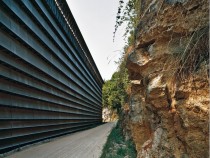
© Margherita Spiluttini
The collaboration between Ricola and Herzog & de Meuron began quite unspectacularly in 1983, when the confectionery company entrusted the two young architects from Basle with the conversion of its administrative centre. For a minimal budget of Sfr 600,000, Herzog & de Meuron gave the building a new internal structure, inserting a two-storey entrance hall and opening the building to the garden. In 2013, the architects were afforded the rare opportunity of restoring their own development to something like its original state. Herzog & de Meuron’s second commission from Ricola, in 1985, involved the conversion of the dwelling house with cafe in the municipal centre, where the master baker Emil Richterich had founded the confectionery factory Richterich & Compagnie in 1930. Here, the architects reorganized the existing building and added a two-storey shop.
With their third structure for Ricola, the outer enclosure of a new high-bay warehouse in the courtyard of the company, Herzog & de Meuron pulled off a masterpiece that not only fulfils the protective function one would expect, but that establishes a relationship to the location and the human scale. In 1991, Herzog & de Meuron made a similarly striking statement with their modular concept for increasing the height of a neighbouring factory. Using huge steel frames set flush with the facades, and without intermediate columns, they spanned the width of the existing two-storey structure and added a further two floors on top.
After the 1992 referendum, in which Switzerland decided not to enter the European Economic Community, it became necessary for Ricola to erect a new sales building for the EEC countries. The structure that Herzog & de Meuron designed for this purpose in Mulhouse, Alsace, resembles a concrete box with two lids tipped up on the long sides. Here, the visual medium and bearer of significance is the facade rather than the structure.
The Ricola marketing structure erected in Laufen in 1999 stands in the garden behind the company headquarters that were refurbished in 1983. It was conceived as a glazed pavilion in which the boundaries between built structure and natural environment dissolve. Projecting out from the top of the inwardly folded entrance facade, for example, is a canopy roof. Over the years, this will gradually be overgrown with climbing plants.
With their third structure for Ricola, the outer enclosure of a new high-bay warehouse in the courtyard of the company, Herzog & de Meuron pulled off a masterpiece that not only fulfils the protective function one would expect, but that establishes a relationship to the location and the human scale. In 1991, Herzog & de Meuron made a similarly striking statement with their modular concept for increasing the height of a neighbouring factory. Using huge steel frames set flush with the facades, and without intermediate columns, they spanned the width of the existing two-storey structure and added a further two floors on top.
After the 1992 referendum, in which Switzerland decided not to enter the European Economic Community, it became necessary for Ricola to erect a new sales building for the EEC countries. The structure that Herzog & de Meuron designed for this purpose in Mulhouse, Alsace, resembles a concrete box with two lids tipped up on the long sides. Here, the visual medium and bearer of significance is the facade rather than the structure.
The Ricola marketing structure erected in Laufen in 1999 stands in the garden behind the company headquarters that were refurbished in 1983. It was conceived as a glazed pavilion in which the boundaries between built structure and natural environment dissolve. Projecting out from the top of the inwardly folded entrance facade, for example, is a canopy roof. Over the years, this will gradually be overgrown with climbing plants.







